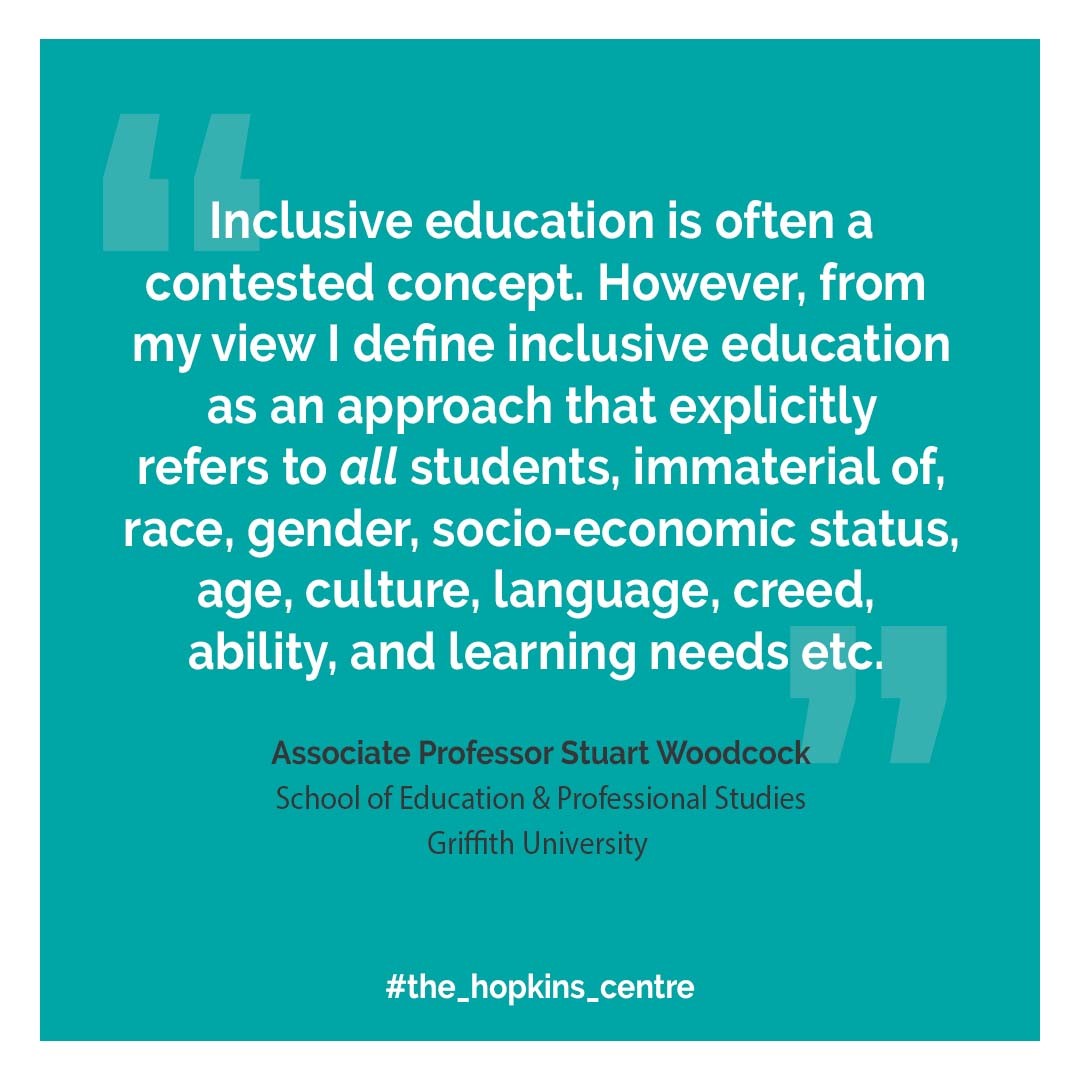Inclusive Education – Part B
Associate Professor Stuart Woodcock
School of Education & Professional Studies, Griffith University


Education is a theme that is present in our Dignity Project research. Our data reflects that access to comparable education is a fundamental piece of dignity for people with disability. This week’s Dignity Project guest is Associate Professor Stuart Woodcock, from the School of Education and Professional Studies, at Griffith University.
__
First, all students need to feel valued, welcomed, accepted, and engaged. When students feel valued and welcomed to their classroom, they feel a sense of belonging which can influence their own self-esteem, their trust in others, and belief in themselves. They will more likely be risk-takers in attempting to participate in tasks where success and failure are part of everyday schooling. Being accepted by all students in the class/school as well as the staff leads students to feeling positive about oneself and of others. It can lead to increased social skills and making friends (all necessary skills for society). Engaging students into the classroom learning environment can help them to want to learn, and benefit toward becoming life-long learners.
Second, the school staff (such as classroom teachers) need to accept, respect, and value all students; make the learning relevant and interesting to every student; embrace the unique characteristics, interests, abilities and strengths, and learning needs of each and every student; and match the teaching to students’ learning needs. As a school staff member (such as classroom teachers), by accepting, respecting, and valuing all students there will more than likely be a stronger rapport between the students and the teacher, respect from students to the teacher as well as each other – making the classroom a positive learning environment. Furthermore, making students feel valued will likely result in better physical and mental health, as well as higher levels of engagement, satisfaction, and motivation to participate. All of these are also more likely to result in a healthy and productive relationship between the teacher and students. All students are different, whether it is their background, interests, strengths, or weaknesses. It is important that the learning considers these – so that the students feel valued, welcomed, accepted, and engaged.
Third, schools need to give all students access and opportunity to learn to their potential; make sure that student needs and characteristics are taken into account through a holistic approach; make sure that all students have easy access to learning and resources throughout the school; and collaborate for better outcomes with students, parents, and community. Students who have access and opportunity to learning at school, and attend school for all on a regular basis, feel more connected their community, and develop social skills and friendships, which are important life skills. These are also important when building inclusive social communities. By making sure that student needs and characteristics are considered, and by removing all barriers to students throughout the school, the learning needs of all students are likely to be met. Furthermore, the ‘village mindset’ is a key to inclusive education across the school. It takes a collective approach on the part of everyone concerned (leaders of the school, teachers, professional staff, parents, students, and community) to ensure that all students meet the educational outcomes – and go on to live fulfilling lives.
Many of these principles are in line with what the Dignity Project promote through their research and work. The Dignity Project focuses on the importance of understanding and representation of each individual. Furthermore, the Dignity Project aims to facilitate choice – where individuals create their own pathways and have their own goals set in a realistic, yet challenging way. It is important to expand opportunities and make sure that all barriers are removed, allowing people to succeed to their potential. Similar to above, the Dignity Project focuses on engaging the ‘village mindset’ in order for collaborative support networks to be utilised.
In a philosophical view towards inclusive education, I see everyone in the classroom (students and teacher) as part of a music band. The teacher is the conductor, and the students are the musicians. The students in the classroom play various instruments, and those who play the same instrument have different parts to play. All together the music is perfect. However, with one set of instruments missing, the sound is not the same. If one student within a group who play the same instrument is not playing their part, the sound is not the same. At times, practices will take place in groups where musicians who play the same instrument will be together, rehearsing their piece. At other times, practices will take place in groups where musicians who play different instruments will be together, rehearsing their piece. All will be rehearsing their piece to make the sound and harmony in the band come together. The teacher’s role, like a conductor’s role, is to make sure that the band come together and play the music that is meant to be to the best of the band’s ability. This philosophical view towards inclusive education incorporates all of the above principles from an environmental context through to the school staff within the whole school.
I have experienced positive and negative examples of inclusive educational settings within Australia, Canada, and the United Kingdom. One positive experience within the United Kingdom, was when I was at a school in inner city London. The school accepted all students, including students that other schools did not consider (potentially, due to overall school performances in standardised tests). These students either performed lowly in standardised tests or end of school exams, and/or they had additional needs/disabilities. The school that I was teaching at took them all in. Nearly half of the students in the school were on some form of individual education plan. In order to make the school inclusive (in relation to the above principles), there were a number of factors that were implemented. Inclusion of all students was a shared responsibility by everyone (including school leaders, teachers, professional staff, students, parents and community). It was important for everyone at the school to believe in inclusive education being an effective way for all students to learn and grow. Collaboration amongst the stakeholders (such as teachers, other professionals, parents) occurred. Not only did this support the shared responsibility, but also helped toward implementing the principles discussed above. By sharing responsibility and
collaborating together, the school was able to implement approaches that were consistent across the school, such as managing student behaviour in a positive way. For example, the staff at the school used WhatsApp as a group to communicate students’ behaviour. If a student was praised outside during recess for something that they had done (out of the ordinary), a message would be sent via WhatsApp to the staff, so that the necessary teachers would be aware – and also praise the student when returning to the classroom. Although it has been mentioned above, communicating with families was one of the strengths within the school being inclusive as it worked across every family within the school which impacted upon all students. The communication with families worked well for students, especially when understanding student needs, interests, strengths, behaviour, and other background information, helping the staff at the school implement the principles discussed above.
If the aim is to create an inclusive culture that accepts, values, and engages everybody – so that everyone feels like they are appreciated, belong, and accountable within society, then it needs to begin and be modelled throughout the school system. Inclusive education is not new, as it has been around for a few decades. However, it is moving forward in the right direction, yet, while it works well in some schools, it still has a way to go in other schools. Therefore, it is necessary to continue in the right direction and work towards creating genuine inclusive schools for all.
_____
We would love to learn more about your experiences with inclusive education or accessibility options/adjustments you have utilised throughout your education.
Some questions to ponder….
What does inclusive education mean to you?
Have you experienced inclusive education? Tell us about it?
Write to us on Community Hub or via email: dignityproject@griffith.edu.au

